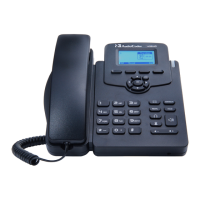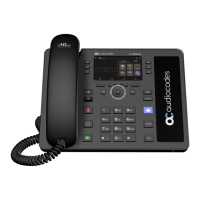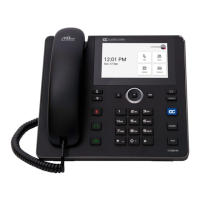Release Notes 3. Previous Releases
Version 2.0.13B 23 400HD Series IP Phones for Skype for Business
3.3 Version 2.0.11
3.3.1 What’s New in Version 2.0.11
The following new features have been introduced in Version 2.0.11:
Factory-Set Certificates and AudioCodes Trusted Root CA. AudioCodes IP phones are now
loaded with factory-set preinstalled certificate files: private key file, certificate file and a Trusted
Root CA file that is signed by AudioCodes. Whenever the IP phone authenticates with a remote
server, it can be authenticated using these certificate files. Each IP phone receives a uniquely
generated private key certificate file based on its MAC address. If the remote server is configured
to authenticate the client and AudioCodes factory-set certificates are used for authentication, then
the AudioCodes Certificate and AudioCodes Trusted Root CA must be downloaded to the remote
server. These files can be downloaded from the AudioCodes Web site. For more information,
contact your local AudioCodes sales representative. If you use the AudioCodes Redirect server to
obtain firmware and configuration files, then the factory-set certificates are used to authenticate the
connection with this server. If default certificate files are missing or deleted, the phone will
regenerate these files automatically the next time it is powered up.
New dialing feature. After entering the digits of a phone number on the keypad, users can now
also pick up the receiver or press the Speaker button for dialing to occur. This is the new default
behavior. Previously, users needed to press the Dial softkey.
When using the handset in a call, if the handset is on-hooked after putting the call on hold, the call
is not disconnected and the audio is switched to the speaker. To maintain backward compatibility,
users can set the configuration file parameter 'voip/onhook_disconnect_when_held/enabled' to 1.
This causes the call to be disconnected in the above scenario, as it was in earlier versions.
New Presence State is now supported: The red BLF LED flashes on and off to indicate when a
contact is in a call. When a contact, who is listed in a user's phone's BLF list, is in a call, the red
BLF LED on the user's phone flashes on and off.
When two incoming calls occur simultaneously, the phone's LCD displays them in a graphically
user-friendly way: the names of the calling parties appear on the LCD and the adjacent incoming
call icons flash. If a user is in a call and a third party calls, the name of the calling party appears on
the LCD and the adjacent incoming call icon flashes.
BToE
• Automatic mute when a paired phone joins a Lync meeting. When a user, whose phone is
connected to BToE, joins a Lync meeting, the phone is muted and the red MUTE button is lit.
The user can unmute using the phone's MUTE button or using the Lync client.
• When answering an incoming video call with a paired phone, the call is established. The
default device is the PC speaker/microphone rather than the phone. Subsequent audio calls
will be unaffected; the paired phone will still be the default device.
New Blind Transfer (BXfer) softkey. A new softkey, BXfer, provides a more convenient way for
users to perform a Blind Transfer.
The feature must be enabled using the 'voip/signalling/sip/sk_blind_transfer/enable' configuration
file parameter. The default softkey is Hold.
Support for Electronic Hook Switch (EHS) DHSG. Answering calls and changing volume level
with EHS-capable headsets is now supported. This newly supported capability can be enabled by
setting the configuration file parameter 'voip/services/electronic_hook_switch/enabled' to 1.
The feature was verified using the following headsets:
• Jabra® PRO 920
• Jabra® PRO 9450
The headset's base unit connects to the phone's headphone port. The Audio connector connects to
the headphones port. The management connector connects to the Auxiliary port using a DHSG
cable which can be ordered from AudioCodes.
Call waiting audial indication (beep progress tone), which can disrupt a conversation, can be
disabled so that only visual indication is enabled. If a user is in a call and a third party calls that

